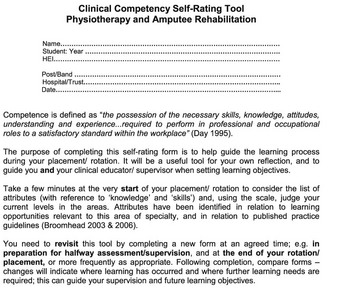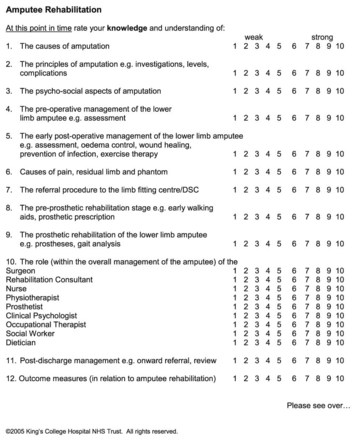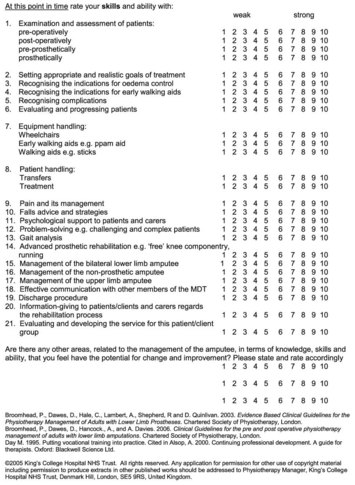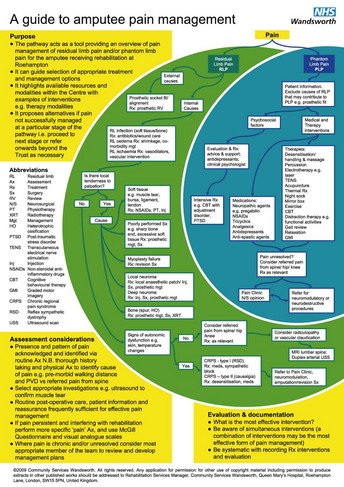Chapter 2 E-materials
Author Profiles
Mary Jane Cole MSc GradDipPhys MCSP
Senior Lecturer, Practice Education, at Kingston University and St George’s, University of London.
Appendix 2.1 Amputees: glossary
ADLs – activities of daily living
Alignment (of the prosthesis) – the biomechanical set-up of the prosthesis to provide stability and as near normal gait pattern
Componentry – any part of the prosthesis below the socket, i.e. knee, ankle unit or foot
Compression sock – an elastic sock of varying lengths to aid oedema control. Brand names include ‘Juzo’ and ‘Ottobock’
Doffing – removing the prosthesis
Donning – putting on the prosthesis
Established patient – an amputee who has completed initial rehabilitation and is returning for review for further prosthetic rehab or intervention/ therapy as appropriate
EWA – early walking aid, e.g. PPAM Aid
Femurett – early walking aid for the transfemoral amputee
Fitting – this is the appointment when the fit of the prosthesis is assessed by the prosthetist and adjustments are made as necessary before the amputee can walk with it
ICT – intermediate care team – also referred to in other terms
Liner – the inner and removable part of a socket
Multiple amputee – combination of upper and lower limb loss
Myodesis – surgical technique where the muscle groups are attached to the bone periosteum
PLP – phantom limb pain – a painful sensation in the phantom limb
PLS – phantom limb sensation – non-painful sensation in the phantom limb
PPAM Aid – pneumatic post-amputation mobility aid
PRAFO – pressure relieving ankle foot orthosis
Primary patient – a patient for whom this is their first episode of rehabilitation following amputation
Prosthetic prescription – the type of limb selected to meet the amputee’s needs
Prosthetics – artificial extension replacing a body part
Prosthetist – the health professional who makes and fits the prosthesis
Residual limb – the amputee stump
RLP – pain in the residual limb, i.e. stump
Sit-Fit – inflated balance cushion
SMART goals – specific, measurable, achievable, realistic and time framed
Socket – the part of the prosthesis that covers and supports the residuum
SRPs – short rocker pylons – short training prostheses for the bilateral transfemoral amputee
Suspension – the means by which the prosthesis maintains the correct position on the amputee
Stubbies – customised sockets, without componentry, with modified rocker ends to aid mobility; serve the same function as SRPs. The end of the socket can be shaped to accommodate the knee disarticulation level
Appendix 2.4 Transtibial prosthetic checkout
Check with patient standing and walking
1. Is the prosthesis the correct length?
3. Anteroposterior alignment – The patient should not feel that his/her knee is unstable nor that his/her knee is being forced back.
4. Mediolateral alignment – The shoe should be flat on the floor and there should be no uncomfortable pressure at the lateral or medial brim of the socket.
Appendix 2.5 Transfemoral prosthetic checkout
Check in standing and walking
1. Does the ischial tuberosity rest properly on the ischial seat?
2. Is the adductor longus tendon properly located in its channel and is the patient free from excessive pressure in the anteromedial aspect of the residual limb?
3. Is the anterior wall high enough to support adductor tissues?
4. Is the prosthesis the correct length?
5. Is the patient free from vertical pressure in the area of the perineum?
6. Is the patient comfortable in the socket? What is the patient’s ‘Socket Comfort Score (SCS)’?
8. Gait and alignment – are there any of the following deviations?















